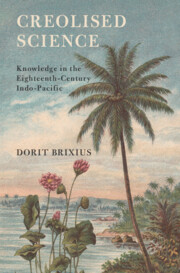Book contents
- Creolised Science
- Science in History
- Creolised Science
- Copyright page
- Dedication
- Contents
- Figures
- Acknowledgements
- Author’s Note
- Abbreviations
- Introduction
- 1 The Limits of French Colonial Visions and Science
- 2 The Acquisition of Knowledge and Plants, from Madagascar to China
- 3 Agriculture and Everyday Knowledge
- 4 Enslaved People as Knowledge Carriers
- 5 The Cross-Cultural Quest for Spices in South East Asia
- 6 Materials, Environment, and the Application of Knowledge
- Conclusion
- Bibliography
- Index
1 - The Limits of French Colonial Visions and Science
Published online by Cambridge University Press: 03 April 2024
- Creolised Science
- Science in History
- Creolised Science
- Copyright page
- Dedication
- Contents
- Figures
- Acknowledgements
- Author’s Note
- Abbreviations
- Introduction
- 1 The Limits of French Colonial Visions and Science
- 2 The Acquisition of Knowledge and Plants, from Madagascar to China
- 3 Agriculture and Everyday Knowledge
- 4 Enslaved People as Knowledge Carriers
- 5 The Cross-Cultural Quest for Spices in South East Asia
- 6 Materials, Environment, and the Application of Knowledge
- Conclusion
- Bibliography
- Index
Summary
Chapter 1 introduces the geopolitical and scientific–colonial context of eighteenth-century Mauritius, primarily from the perspective of its governance. Mauritius was a French colony, and a very expensive one to run. It was managed by the Compagnie des Indes (CIO) until 1763 and then, in the aftermath of the Seven Years War (and dissolution of the CIO), was purchased by the French crown. By setting out the hidden dynamics of empire, this chapter provides a detailed discussion that explains why Mauritius was primarily a stopping-off point in the period under review rather than an island of commerce. A key finding concerns the internal divisions within the island over its management and policy, which is an important revision to prevailing assumptions in the historiography that such interests would be divided between policymakers in the metropole and those in the colony, where each has been assumed to represent a unified view. Hence, it examines the various experiments in colonial autonomy undertaken on Mauritius between the 1760s and the 1780s, including the complex alternatives relating to the agents who tried to build networks through alliances with local actors and Indigenous populations in the Indo-Pacific region. Lastly, this chapter spotlights the use of enslaved people in various projects in the island.
Keywords
- Type
- Chapter
- Information
- Creolised ScienceKnowledge in the Eighteenth-Century Indo-Pacific, pp. 18 - 50Publisher: Cambridge University PressPrint publication year: 2024

